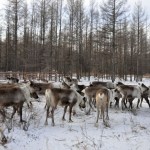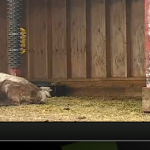reindeer
New research presented at the British Ecological Society, Liverpool shows that reindeer are shrinking. These findings come from a survey conducted between 1994-2010 in Svalbard, a Norwegian island, which found the animals have lost about 12% of their body mass over this timeframe. The research team thinks the shrinking reindeer phenomenon might be caused by global warming as females have increased access to grasslands and give birth to more calves annually than in the past. This translates to less nutrients available to support each gestation causing lower birth weights…
I came across a neat article in Scientific American that described how reindeer and elk regrow their antlers every year. Could you imagine putting that much energy into growing new bone each year complete with a velvety cover containing nerves, skin, and blood vessels? Although full-grown antlers lose their blood supply and animals scrape the velvet layer off to reveal just bone.
Researchers have explored whether understanding this amazing process of annual antler regeneration could lead to new therapies to regrow nerves or organs in humans. The nerve fibers that…
Image of Aoluguya reindeer from www.chinatouradvisors.com
Scientists have now determined the complete mitochondrial genome sequence of Aoluguya reindeer (Rangifer tarandus). I wonder if the sequence will hold any more clues as to why Rudolph's nose is so red and bright. Although according to this prior blog entry perhaps it was the other 8 reindeer who were different...
Source:
Ju Y, Liu H, Rong M, Yang Y, Wei H, Shao Y, Chen X, Xing X. Complete mitochondrial genome sequence of Aoluguya reindeer (Rangifer tarandus). Mitochondrial DNA. 3:1-2, 2014. [Epub…
Unlike Santa's reindeer living in the lap of luxury at the North Pole, wild reindeer that live in the barren tundra have to find their own food. Being too chilly for trees, the tundra is hospitable to only shrubs, grasses and lichen, which are abundant during the warmer seasons. However, during the winter when the grasses and shrubs are scarce reindeer survive off lichen, comprised mainly of quick-energy in the form of carbohydrates. In fact, they reportedly eat about 4-11 pounds of lichen each day.
Source:
Animal Planet
You may be too young to know the truth about Santa Claus, but dear old Saint Nick is not the affable Anglo-Saxon philanthropist he appears to be. In fact, evidence suggests that he is an unholy creature of the night, an ancient vampire who would suck your blood if you didn't placate him with milk and cookies.
Saint Nicholas was born in Turkey in the third century AD, more than 1700 years ago. Although rumored to have perished at the age of 73, he must have been trans-substantiated by some forgotten fiend. Turned into a being that would burn in the light of day, old…
Every now and then, more often than you might expect, I mention something in lecture (usually in a classroom in front of students) and a small number of individuals express incredulity that the thing exists. Pygmies are one of those terms that garners disbelief. Many people assume they are made up. At the same time, a disconcerting number of times the opposite happens. Mermaids, aliens, dragons, Atlantis, etc. are not real but many students, educated by the History and Discovery channels, apparently, (I don't watch them but I hear things), think they are.
Strangely, one of the things…
Scientists have discovered just what makes Rudolph's nose turn red:
c/o Reindeer Owners and Breeders AssociationWhat could be cuter than a little baby reindeer around the holidays? Not much! Reindeer (Rangifer tarandus, or Caribou) have become a holiday staple for their sleigh pulling behavior. The large beasts are a kind of deer, native to North America, that travel great distances every year in search of food. Babies can run faster than a wolf only minutes after they're born!
But what you might not know is that Santa's reindeer, even ole Rouldolph himself, have to be girls - at least if the classic pictures are correct. That's because, according to the…
Ring in the holidays with yuletide logs... courtesy of the reindeer at the Miller Park Zoo. By combining two Christmas classics, reindeer and ornaments, and adding a twist - fecal matter - the zoo's marketing department may of stepped in retail gold!
In a nutshell, or a nugget if you will, keepers collected reindeer poop balls, rolled them in glitter, and allowed them to dry. The final product was then packaged in little boxes and sold with a certificate of authenticity, a move straight out of the Danbury Mint's playbook. Explains Susie Ohley, Marketing Director of the Miller Park Zoo, "Each…



